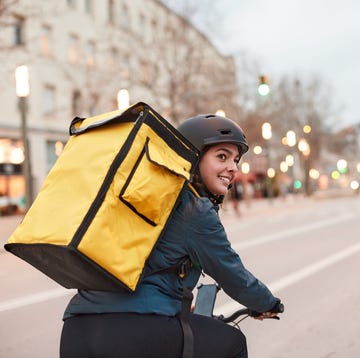Summer is finally here, and the chances are you're taking advantage of the opportunity to spend more time in the great outdoors. But just as you need to look after yourself during a heatwave by wearing SPF, staying hydrated and keeping as cool as possible, it's also important to take precautions for your pet when it gets hot.
Recent research by global pet brand PetSafe found that 75% of pet owners didn't know how much water their pet should drink each day, while 80% didn't know the signs that their pet was dehydrated and just over a third monitored how much water their pet drank.
However, an increase in body temperature of just a few degrees can put your pet at risk of heat stroke – if you're a pet owner, then, it's crucial that you know how to keep your pet cool during the warm summer months.
From spotting heatstroke in animals to keeping them hydrated, deciding whether it's too hot to walk your dog, and how to keep your pets cool during a heatwave, here's everything you need to know to keep your pet happy and safe from harm.
Keep your pet hydrated and cool
We're aware of the importance of keeping hydrated, and the same goes for our pets. According to PetSafe, your furry friend needs 70ml of water for every 1kg of weight. A Westie, for example, will weigh around 10kg so should drink 700ml daily. A bigger dog, like a Labrador, could weigh around 30kg so will need 2.1 litres a day.
Adding water to your pet's dry food is a simple way to introduce more water to their diet and experts recommend putting an ice cube or two in their water to keep it cool.
Preparing a Kong fillable toy with mashed banana or dog food and then freezing it is a great long-lasting treat for a hot day, says the RSPCA. You can also give your pup DIY treats made with bases like watermelon or chicken stock – you'll find plenty of dog treat recipes online. Lick mats are also a helpful addition as dogs also take comfort in licking.
Canines love a refreshing dip in a pool, too, so why not take them to a dog friendly beach or let them lounge in a paddling pool in a shaded part of your garden?
When in doubt, don't go out
Walkies may be your dog's favourite part of the day, but during a heatwave, you're better off keeping them inside.
“One of the biggest heatstroke triggers is exercise in hot weather," says Shauna Walsh from the PSDA, the vets charity for pets in need. "In fact, research shows that 74% of heat-related illness in dogs seen by vets is caused by exercise in high temperatures.
“It’s best to stay indoors for the hottest part of the day," she adds. "This is generally around mid-afternoon, so if you’re planning on being outside, aim for the early morning or evening. Remember, even at these times the weather can feel uncomfortably close or humid during a hot spell, so think about skipping the walks and playing some games in the house instead."
If you do take your dog out, avoid strenuous exercise like running or games of fetch. Stick to gentle walking and allow them plenty of time to sniff so that their brains stay active. If your pet is desperate to get outside in the hot weather, play some water games in the garden with your pooch to keep them cool, and stick to grass rather than hotter surfaces such as pavements. If it's too hot to touch with your hand for more than a few seconds, then it's too hot for your pet's paws.
Many cats like to frolic about outside on their own, but according to Shauna, you should try to encourage them to stay in during the hottest part of the day.
"Many cats will seek out cooler spots, but if you have a sun lover, you may need to step in and bring them inside out of the heat. You can encourage them to nap indoors during the heat by playing with them at dawn and dusk, and offering their breakfast a little later to persuade them to stay at home.
"Give your cat the opportunity to head out in the early morning and later in the evening if they want to when temperatures have dropped."
Apply animal suncream to sun-loving pets, in particular those with light fur or exposed skin. White cats, for example, are particularly susceptible to sunburn on their face and ear tips, and prolonged exposure can even result in skin cancer.
Never leave your pet in the car
This is a golden rule most dog owners are aware of, but it's worth repeating. Cars can overheat very quickly, and even if you are parked in the shade or you keep the windows open, leaving your dog in the car when it's hot can be fatal. It doesn't have to be that hot outside for the car to quickly feel like an oven. When it's 22 degrees Celsius outside, the car could reach an unbearable 47 degrees within an hour.
If you're out and about and you see a dog in distress in a hot car, dial 999. If you see a dog in a car that appears to be okay, the RSPCA recommends:
- Trying to work out how long the dog has been in the car. A pay and display parking ticket could help with this
- Make a note of the car's registration in case you need to report the owner
- At a shop, venue or event, ask the staff to alert the owner over loudspeaker
- Make sure you stay with the dog and assess its condition
You can call the RSPCA's advice helpline on 0300 1234 999, but they stress that you should be ready to call 999 as your first step if the dog is in danger.
"If the dog's condition is critical, and the police haven't arrived yet, your instinct will be to break into the car to free them", says the RSPCA. "But please be aware that this could be classed as criminal damage. You may need to defend your actions in court, so please be sure you're doing the right thing. Legally, you can commit damage if you believe the car owner would consent to it if they knew the dog was in danger."
Cut back their coat
Hot weather can be particularly uncomfortable for pets with long fur. When a heatwave is on the way, you can prepare by having your dog's coat trimmed or thinned to prevent overheating. Some breeds of dog have a coat which isn’t suitable for clipping, so you should seek advice from your groomer.
Give your dog or cat a brush every day that the weather is hot, to remove excess fur and help keep them cool.
Know the signs of heatstroke in pets
Just like us, our pets can get seriously ill if they overheat, so it's important to be aware of the signs that they may be suffering from heatstroke.
Is your dog or cat at risk of heatstroke?
Some dogs are more susceptible to heat stroke because of their coat and face shape:
Dark coats soak up the most sun rays – more than ginger, grey and blonde fur. But pets with white fur are also more susceptible to burning.
Shaggy coats absorb more of the heat than short coats.
Pets with short face shapes and squished noses, such as Persian cats and Pugs are more at risk than those with longer face shapes and noses. Dogs, in particular, lose a lot of heat by panting but long wet noses act as an effective heat control.
Older animals' bodies are also less able to regulate their temperature.
According to the online retailer Yappy, which sells personalised pet products, the dog breeds most at risk of heatstroke are:
- Chow Chow
- Bulldog
- French Bulldog
- Greyhound
- Dogue de Bordeaux
- Cavalier King Charles Spaniel
- Pug
- Golden Retriever
- Springer Spaniel
How to tell if a dog is suffering from heatstroke
Dogs suffering from heatstroke will pant more and their gums may be dry, sticky or discoloured. Excessive drooling or vomiting are telltale signs. If your dog appears lethargic or disorientated, this could also be a sign of heatstroke.
If you have noticed the signs of heatstroke in your dog, it's important to take immediate action.
"Move your dog to a shaded area and offer small amounts of water," canine expert Rachel Bean says. "Lie the dog on a wet towel and wet with tepid water, directing a fan on the dog – or if you’re in the car, switch the air con on. This is the safest way to cool a dog down quickly."
The RSPCA has this checklist for what to do if your dog has heatstroke:
- Move the dog to a shaded and cool area
- Immediately pour cool (not cold to avoid shock) water over the dog. Tap water (15-16°C) has been found to be the most effective at cooling dogs with heat-related illnesses. In a true emergency, any water is better than nothing.
- Wet towels placed over the dog can worsen the condition, trapping heat. In mild cases towels can be placed under the dog, but never over, and in a true emergency water immersion or pouring water with air movement is ideal.
- Allow the dog to drink small amounts of cool water
- Continue to pour cool water over the dog until their breathing starts to settle, but not too much that they start shivering
- Dogs that have lost consciousness will stop panting, despite still having a very high temperature, these dogs require urgent aggressive cooling as a priority.
- Throughout the treatment of heatstroke try to avoid pouring water on or near your dog's head, as there is a risk of them inhaling water which could lead to drowning, especially for flat-faced and unconscious dogs.
You should then call your vet for further guidance.
How to tell if a cat is suffering from heatstroke
Cats usually suffer from heat exhaustion before it develops into heatstroke, according to the London Cat Clinic. Both require immediate action.
At first, your cat may lie around a lot and look lethargic, possibly dribbling and foaming at the mouth. Serious heatstroke may cause your cat to collapse and their gums could become bright red.
Heatstroke treatment for cats is similar to dogs: take your pet to a cool, shaded area and offer water. Do not force them to drink. Place a cool, wet towel under your cat — this should be changed every five minutes.
Again, once you've started this process you should call your vet to see if your pet will need further treatment.
GH Tip: When cooling your pet down with water, make sure it is not ice cold as this can reduce blood flow to the skin and reduce their ability to cool down.


















